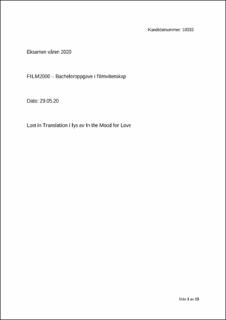| dc.contributor.advisor | Leyda, Julia | |
| dc.contributor.author | Fjellum, Thomas | |
| dc.date.accessioned | 2020-07-16T16:01:11Z | |
| dc.date.available | 2020-07-16T16:01:11Z | |
| dc.date.issued | 2020 | |
| dc.identifier.uri | https://hdl.handle.net/11250/2669325 | |
| dc.description.abstract | I denne oppgaven går jeg gjennom Sofia Coppolas film Lost in Translation (2003) og ser på den i lys av Wong Kar-wais In the Mood for Love (2000) Helt i begynnelsen gir jeg en kjapp gjennomgang av handlingene i de to filmene. Deretter etablerer jeg hvordan Lost in Translation står i forhold til andre lignende filmer sjangermessig, for å finne ut hvor den kan plasseres. Her finner jeg ut at filmen hovedsakelig er et drama, men den har elementer som også kan plassere den som en romanse-film og en komedie som den ble markedsført som. Til tross for komedien i filmen, er det filmer som Before Sunrise (1995) og Brief Encounter (1945) som ligner mest, mye på grunn av handlingen i filmene. Deretter går jeg over til å etablere hvordan en film som In the Mood for Love blir forskjellig på bakgrunn av produksjonsland, og hva som er særpreget på en slik film fra Hong Kong.
I analysen min går jeg nærmere inn på hva forskjellene og likhetene mellom Lost in Translation og In the Mood for Love er. For eksempel finner vi ut hvordan de to karakterene i sine respektive filmer har likhetstrekk, hvordan filmene gjemmer unna ektefellene til karakterene og hvorfor, og hvordan filmene bruker hver sin asiatiske storby for å få karakterene våre til å føle seg alene. Etter å ha etablert hva som går igjen tematisk i filmer fra Hong Kong får vi også sett nærmere på hva som faktisk skiller to lignende filmer fra to forskjellige steder, og hvordan det endrer filmene. Her går vi også inn og ser på hvordan 40 års skille i når filmens handling er satt endrer deler av filmene.
Ved å gå gjennom dette, finner vi ut hvordan filmer fra Hong Kong og USA fra den tiden blir forskjellig mye på grunn av nettopp hvor de er fra. Tidspunktet filmene er satt til har også mye å si for hvordan karakterene føler seg rundt situasjonen sin. Coppola brukte flere lignende metoder som Wong for å etablere karakterer og situasjoner, men ulikhetene mellom stilart, sjanger og setting er ikke overraskende nok til å skape to veldig forskjellige filmer. | |
| dc.description.abstract | In this paper I'm going to go through Sofia Coppola's film Lost in Translation (2003) and look at it in light of Wong Kar-wais In the Mood for Love (2000). In the beginning I'm going to give a quick rundown of the plot of the two films. Then I'll establish how Lost in Translation stands compared to other similar films by genre, to figure out how to place it. In this section I figured out that it was mainly a drama, with elements which can also place it as a romance and a comedy, as it was marketed as. Despite the comedy in the film, it's films like Before Sunrise (1995) and Brief Encounter (1945) that's the most similar, mostly due to the plot. Furthermore I'm going to go thorugh and establish how a film like In the Mood for Love will seperate itself due to country of origin and what's special about this kind of film from Hong Kong
In my analysis I'm go deeper into the differences and similarities between Lost in Translation and In the Mood for Love. For example, I figured out how the two characters in their respective films share similiarities, how the films hide away the spouses of our characters and why, and how the films use their Asian metropolis to get out characters to feel alone. After establishing what themes is shared by the cinema of Hong Kong I'll get to look closer into what's actually seperating two films from two different places, and how it affects the films. In this section I'll also discover how a 40 year gap between the settings change the films.
By going through this, I'll figure out how films from Hong Kong and the USA from that time period is going to be different just by where they're frmo. The time in which they are set also have a lot to do with how the characters deal with their situation. Coppola used multiple similar methods as Wong to establish character and situations, but the differences between style, genre and setting is not surprisingly enough to create two very different films | |
| dc.publisher | NTNU | |
| dc.title | Lost in Translation i lys av In the Mood for Love | |
| dc.type | Bachelor thesis | |
